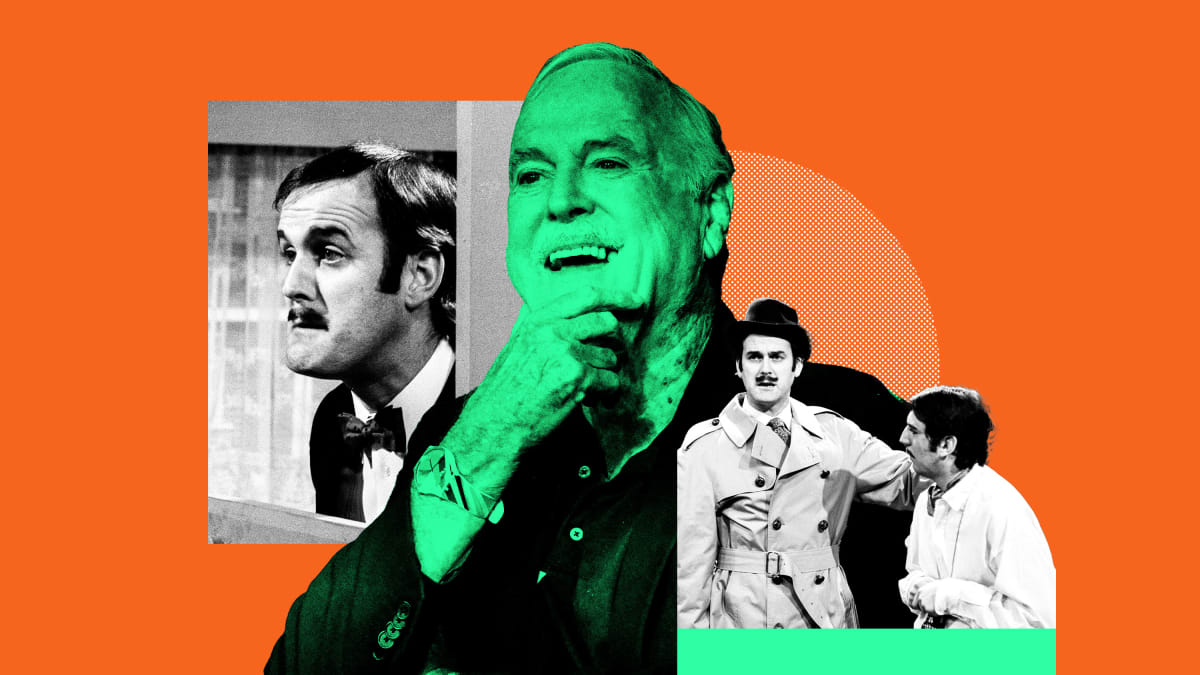Fifty-five years after he became a star on the groundbreaking British sketch comedy series Monty Python’s Flying Circus, John Cleese has hardly slowed down.
Along with several percolating TV and film projects—I personally can’t wait for Lookalikes, in which actual Hollywood celebs play their for-hire doppelgangers—Cleese, 84, is writing a stage adaptation of Monty Python’s Life of Brian. He’s also got a stage play of Fawlty Towers—the sitcom he created and starred in post-Flying Circus—in the works, plus a Broadway-bound “comedy/musical” version, as he calls it, of the Oscar-nominated film A Fish Called Wanda.
“The thing about getting older—and I really mean this—is that I think you become more authentic,” Cleese recently told me. “You have less energy for bullshit. But I have plenty of energy for things that I’m interested in.”
Just a few years ago, after reuniting with his Monty Python pals in 2013 and releasing an excellent (but Python-free) memoir, it seemed Cleese was taking a victory lap of sorts. But the actor and comedian—who in recent years has also become the bane of both the left and right, particularly on social media, where he came under fire last week for listing five ways that “Hitler was preferable to Trump”—seems to have more on his to-do list than ever. These days, that includes setting the record straight on some Monty Python lore.
Cleese, who co-wrote and starred in three seasons of the Monty Python’s Flying Circus television show, as well as three Python films, plus fellow Python Terry Gilliam’s Time Bandits, is now in the early stages of writing the second volume of his memoir. He promises this one will be “all Python; 100 percent. Not just the television series, but the films, too.”
“A lot of research has been done,” Cleese tells me the day after Christmas—shortly before posting the aforementioned Hitler tweet—from the California home he’s rented for the next few months. “A former assistant of mine has been working on it quite diligently for some time, and recently we looked through all of Michael Palin’s papers, which are in the British Museum, and looked at Terry Jones’ stuff, and it’s very easy for me to remember with pretty high accuracy what Graham [Chapman] and I wrote, and pretty high accuracy what Eric [Idle] wrote. But then we are also going to break down who wrote what, even within the pairs who wrote together. We’ve learned some amazing things!”
As a result of that research—and no doubt with an eye toward setting the record straight for history—Cleese sounds excited to tell the story of who wrote what behind the scenes of Monty Python, and how the fabled troupe’s most anarchic, astonishing sketches and scenes came to life.
While Cleese normally wrote with Chapman, who died in 1989, he actually penned the infamous Flying Circus sketch where Hitler stands for election with Palin. “That was exceedingly rare, but I think people, especially Python fans, will find the details of things like that fascinating,” he says.
As a bit of a teaser, Cleese has broken down the genesis of some of Monty Python’s most iconic creations for The Daily Beast.
The “Cheese Shop” sketch
“I was seasick during a shoot. It was a rough day and I had to get on a boat and I’m a bad sailor. On the way back to London, Graham said, ‘You’ve thrown up quite a lot. You should eat something.’ But it was late. We couldn’t find a shop that was open. Graham and I were looking, and then I said, ‘Well, there’s a chemist. Do you think they sell cheese?’ Graham said, ‘Well, if they did, it would be medicinal cheese.’ And we both laughed, and we thought, we’ll write that tomorrow. A man goes into a shop and talks about medicinal cheese and of course, the chemist shop would have medicinal cheese.”
“When we sat down to write it the next morning, literally, we said, ‘Why would anybody go to a chemist to buy cheese?’ And the answer was, ‘Clearly, they’ve been to a cheese shop. They didn’t have any.’ So we never wrote the original idea. But when I was writing it, I kept losing faith in it, and I kept saying, ‘Graham, is this really funny? It’s just a list of cheeses?’ And he was sitting there, puffing away, saying, ‘It’s funny.’ And I’d write a few more. I had a list of cheeses. I’d been to a shop, a big delicatessen, and I’d written down the names of all of them. I kept asking him, but he’d say, ‘It’s fine, it’s fine.’”
“When we started to read it out to the others, it was complete silence for about 30 seconds, and I thought, oh no. And then Palin started to laugh, and he lost control and he literally fell off his chair and lay on the ground rolling around. It’s a good example, because when we read stuff out, the way people reacted, it was with their gut, whether they thought it was funny. But it was never any sort of voting. It was, did people laugh or not?”
“When we started, we had absolutely no idea what we were doing or what we were going to do. But we realized, if you are writing a sketch show, then every single sketch has got to work as well as every other sketch. Whereas in a film, you can have some scenes that are funnier than others, but the less funny ones can give other things, like plot and characters. So, when we started, Graham and I wrote several sketches set in Harrods, in the toupee department, with all these guys selling toupees, all wearing the most terrible toupees. Then there was the ant department, where people had ants as pets. In the end, we kicked 90 percent of it out. Ninety percent!”
“Some of that stuff, like the two I just quoted, appeared in the fourth series [of Flying Circus] after I’d gone. They said, ‘Can we use it?’ And I said, ‘With my blessing.’ But the extraordinary thing was that it really all began when Michael came up with the idea of using coconuts rather than having horses, which we couldn’t afford anyway, and then that stupid conversation about the airspeed velocity of an unnamed swallow. We thought, that’s it—it’s all going to be set in medieval times. And then we just started to write.”
The “taunter” scene, the Black Knight, and more from Monty Python and the Holy Grail
“Graham and I discovered that, historically, they’d have someone go out and taunt the other armies, which is quite an extraordinary thing to do, and what a terrible job to do if your army lost, because they’d be looking for you, wouldn’t they? So we wrote a taunter sketch from that. And then, I knew a little about history at the time and the weird ideas they had in terms of what was science in those days, so we wrote the witch sketch. And then I told Graham a story I’d heard when I was 15, told to me by my English master, about a wrestling match in Rome where the wrestlers had got into a kind of pinch, and one of them, under the huge pressure that they were straining, one of his arms broke. And the referee separated them and sent the guy off to get his arm set by a doctor, and said to the other guy, ‘You won.’ And the other guy was dead. Graham and I then sat down and wrote ‘The Black Knight.’”
“And Michael wrote some wonderful stuff. He wrote the one where his character goes into the castle where all the pretty girls are, and he wrote the bit with the shrubbery and ‘The Knights Who Say Ni.’ More or less, he and Terry wrote everything Graham and I didn’t write. And then Eric wrote the ‘Brave Sir Robin’ song, which is very good, and the three-headed knight, which didn’t end up in the film. It’s in Spamalot now. So we put that all out on the table, and we started to find a sort of shape to the story, although I always thought the ending was a total joke.”
“What have the Romans ever done for us?” in Monty Python’s Life of Brian
“We were having lunch in an Indian restaurant in London with a journalist who said, ‘What are you doing now after the success of Holy Grail?’ And Eric said, ‘We’re going to do a show based in the Holy Land called Jesus Christ Lust for Glory.’ And we all fell about, but didn’t take it seriously. Then, not long afterwards, we started saying to each other, ‘I think that’s not such a bad idea.’ So we put aside three weeks, or something like that, to write stuff. So ‘What have the Romans ever done for us’ came from the historical readings we were doing. It was Terry Jones’ idea, but he didn’t do dialogue as skillfully as Graham and I did, so at some point we said, ‘Can we have a go at it?’ And the final version is what Graham and I had done to his wonderful first idea. What’s so funny about that sketch is that it’s the only sketch ever written that’s pro-imperialism.”
“Blessed are the cheesemakers” from Monty Python’s Life of Brian
“Graham and I went to Windsor Castle because he had a contact with the chaplain there who taught us all about Q, or Quelle, which is the source of two of the gospels. That’s why we wondered, ‘Well, what would it have been like? Would there have been people in the crowd who couldn’t hear what Jesus was saying?’”
The “stoning” scene in Monty Python’s Life of Brian
“Graham and I did a lot of reading. That’s how we came up with stuff like the stoning scene. And I think it always helped that I’d done a couple of years teaching, so it was very easy to switch into teacher dialogue. My favorite line in the whole thing is, ‘Nobody is allowed to stone anyone until I blow this whistle.’ There’s something about the insanity of it. And of course John Young, who played the guy who was going to be stoned, was wonderful. But for that, we got the idea of the stoning, and then we wrote it very, very easily. We thought, funny idea, and of course, women weren’t allowed to go to the stoning, so we had them go to get the beards. We wrote the scene where they go and the guy tries to sell them stones but then offers them beards, because all the women had to pretend to be men.”
“It all came together very easily, and I still remember that we shot that on the first morning of the shoot. Terry Jones, who was our director, was so beautifully prepared. It didn’t feel like the first day of a shoot. It felt like we’d been shooting for weeks. I’m not sure that Jonesy ever got the accolades he deserved. He was just taken for granted. Anyway, we just got out there and it was all ready and by lunchtime I had that fucking beard off, because it itched like hell, and I was swimming in the hotel swimming pool.”
Pontius Pilate talking to the crowd in Monty Python’s Life of Brian
“At the end of the three weeks of writing—me and Graham, Terry and Michael, and, of course, Eric wrote the song ‘Always Look on the Bright Side of Life,’ which is very good, but is all I remember of his that made it into the final film—and Michael read out Pontius Pilate talking to the crowd. When he read that out, I thought, ‘My God, we have a movie.’ And when we got back together again, that had given us the beginnings of a shape. Then we started to write more of the story and not just bits. Because the bits Graham and I had been writing up till then were a bit like the bits in Holy Grail. They could’ve gone in anywhere. They weren’t about the plot. But once we realized we’d got some dots on the graph, we started connecting those dots.
“I’ll tell you one thing, which people tend to forget, is that a good team, they’re not all good at the same things. I’ve realized that you tend to think of a great team all being good at everything, and the answer is, for example, I was terrible at music, while Eric was very strong at music. Jonesy was a wonderful director, but was not very good at dialogue. I think Graham and I were very good at dialogue, but didn’t necessarily have the big ideas. Gilliam was a genius at his animation. And Michael had a lovely, slightly old-fashioned charm about a lot of what he wrote. All these different people who were good at one thing and not so good at another, that’s what made us such a good team.”





